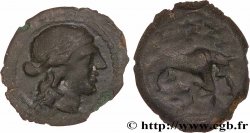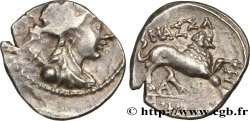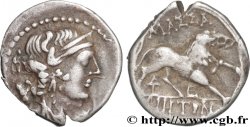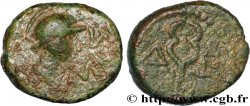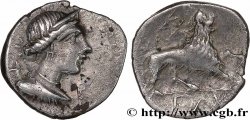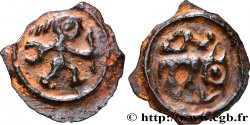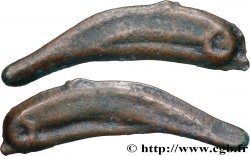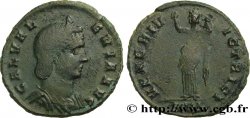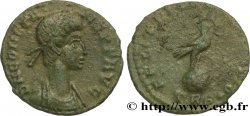Obverse
Obverse description : Tête de Minerve à droite, coiffée du casque corinthien.
Obverse legend : MAS
Reverse
Reverse description : Guerrier debout.
Commentary
Historical background
MASSALIA - MARSEILLE
(5th - 1st century BC)
Marseille, the "Massalia" of the Greeks, founded by the Phocaeans in 600 BC. -VS. , was born from the desire of the Greeks to promote trading posts in order to compete with the Carthaginians and the Etruscans for the domination of the western Mediterranean. The very foundation of the city is mythological. When the young Marseille, Protis, leader of an expedition, landed in a creek, he was received by Nannos, king of Segobriges and married his daughter Gyptis. The Greek received as a dowry a cove around the Lacydon, a natural port located on the site of the current Old Port. Marseille is absolutely not a Celtic or Gallic creation and belongs to the Greek world. Thanks to its metropolis, the colony developed and received additional population from its metropolis with people who fled the Persian danger at the beginning of the Persian Wars (494-479 BC).. -VS. ). The Greeks, who perfectly mastered the rules of maritime navigation and trade, set up trading posts or colonies on the western coasts of the Mediterranean, from Emporium (Aumpurias) to Nikaia (Nice) via Agathè (Agde), Olbia (Hyères) and Antipolis (Antibes), without forgetting that of Alailia (Aleria, Corsica), founded in 565 BC. -VS. The Massaliotes tried with more or less success to trade with the hinterland and the Salyan tribes. They nevertheless founded the outposts of Avenio (Avignon) and Cavaillo (Cavaillon). Between the 4th and 1st centuries BC. -VS. , the Gulf of Lion is often compared to the Gulf of Marseilles, which clearly shows the role played by traders and sailors from Massalia. Marseille, from the outset had to face a double danger which would be its strength: inside, it had to fight against the native Ligurian tribes; outside, it must face the Carthaginian maritime power which extends its hegemony over the islands of the western Mediterranean, Corsica, Sardinia, Sicily and the Balearic Islands. Political power is in the hands of a Greek oligarchy composed of the Council of Fifteen and a Boulé of six hundred members. Very early, from the 6th century, the Massaliotes placed themselves under the protection of Apollo Delphian and Artemis who are found on the coins of the city.. A temple dated to 530 BC. -VS. , dedicated to Apollo, was also found in the excavations undertaken from 1967. The capture of Phocaea by the Persians, circa 540 BC. -VS. , made Marseille a metropolis that soon spread throughout the western Mediterranean, despite the Carthaginian presence and the commercial competition of the Etruscans. Between the 5th and 1st centuries BC, Marseille and its hinterland experienced unprecedented development. Marseille experienced great prosperity in the 5th century BC.. -VS. , thanks to a period of tranquility in the western Mediterranean after the Carthaginian defeat at Himera in 480 BC. -VS. The Etruscans were in turn defeated by the Syracusans at Cumae. For nearly seventy years the Massaliote ships were able to sail quietly through the waters of the Tyrrhenian Sea.. The Sicilian Affair in 413 BC. -VS. and the Athenian and then Carthaginian intervention, accompanied by the destruction of Agrigento, led to a serious conflict which was to last half a century and extended to Magna Graecia (Southern Italy). The 4th and 3rd centuries BC seem to be a more difficult period, marked by the economic recession of Marseilles. The Carthaginians prove to be formidable competitors both in the western and eastern Mediterranean. The fall of Athens, the political and economic problems experienced by Sicily and Syracuse in particular, must have affected the Massaliote trade. In Gaul, in the hinterland of Marseille, the city had to face the incursions of the Ligurian tribes. Opposed to Carthage, very early the Massaliots seek the friendship of the Romans (from before the beginning of the first Punic war). The Marseillais will provide triremes and other quinqueremes to their Roman ally. However, at the beginning of the 3rd century BC, they took a dim view of the conquest of southern Italy (Major Greece) by the Romans, which ended with the capture of Taranto in 272 BC.. -VS. The rise of Rome from the First Punic War (268-241 BC). -VS. ), and the strategic choice of Marseilles, which plays Rome against Carthage, will restore, in the second half of the third century BC, a preponderant role to Massalia in the international trade of the western Mediterranean.. The second century BC marks the decline of the Phocaean city. Privileged ally of the Romans, Marseille has, thanks to them, succeeded in imposing its power in the Marseille hinterland. The Romans, by stopping the Cimbri and the Teutons, saved southern Gaul from invasions. From 118 BC. -VS. , the situation changes and the Provincia becomes a Roman province. Marseille merchants compete with Roman traders in Spain, Corsica, Sardinia and Sicily. Nevertheless, they remain the allies of the Romans until the 1st century BC.. This is the beginning of the civil war between Caesar and Pompey in 49 BC.. -VS. which will be fatal to the city. Marseille did not know how to choose between the two protagonists. Caesar besieged and took the city, not being able to allow his lines of communication between Gaul and Italy to be cut off.. Marseille's fleet was still too large to fall into the hands of his mortal enemy, Pompey. Conquered, the city was nevertheless not plundered and remained an important port at the beginning of the Roman domination. Remaining Hellenic, it was never really assimilated to Roman Gaul and kept a kind of independent status, mixed with cosmopolitanism where all religions crossed all races for the greater benefit of Marseille trade..







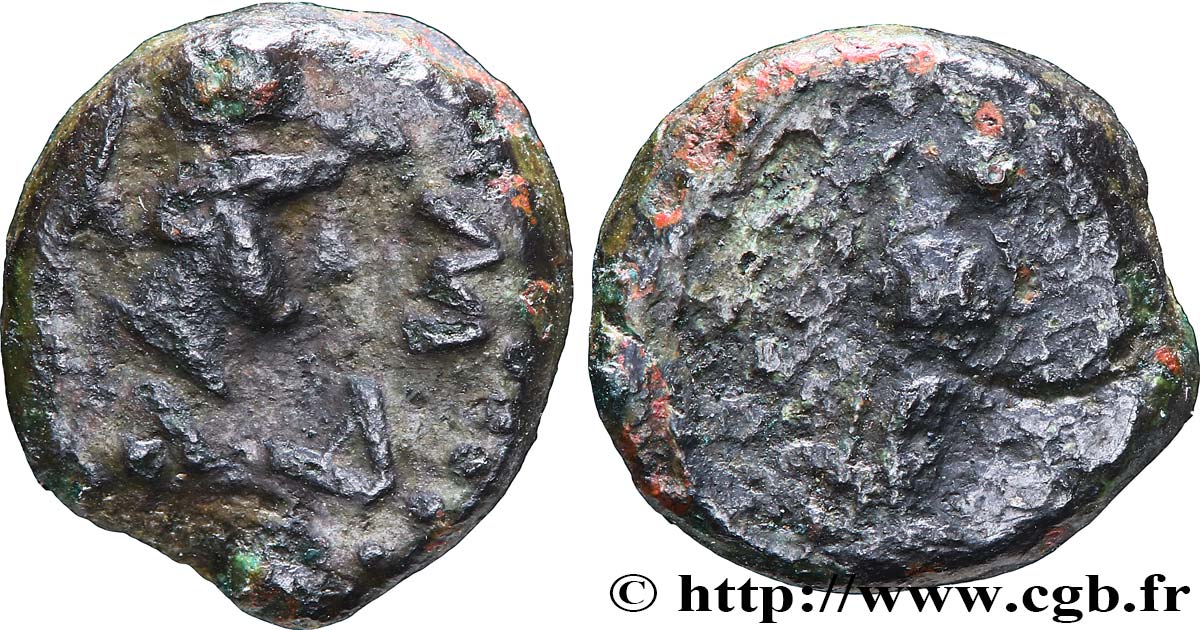
 Report a mistake
Report a mistake Print the page
Print the page Share my selection
Share my selection Ask a question
Ask a question Consign / sell
Consign / sell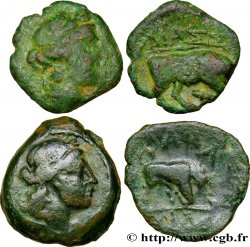
 Full data
Full data